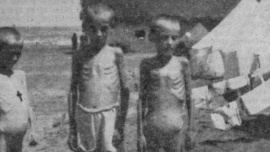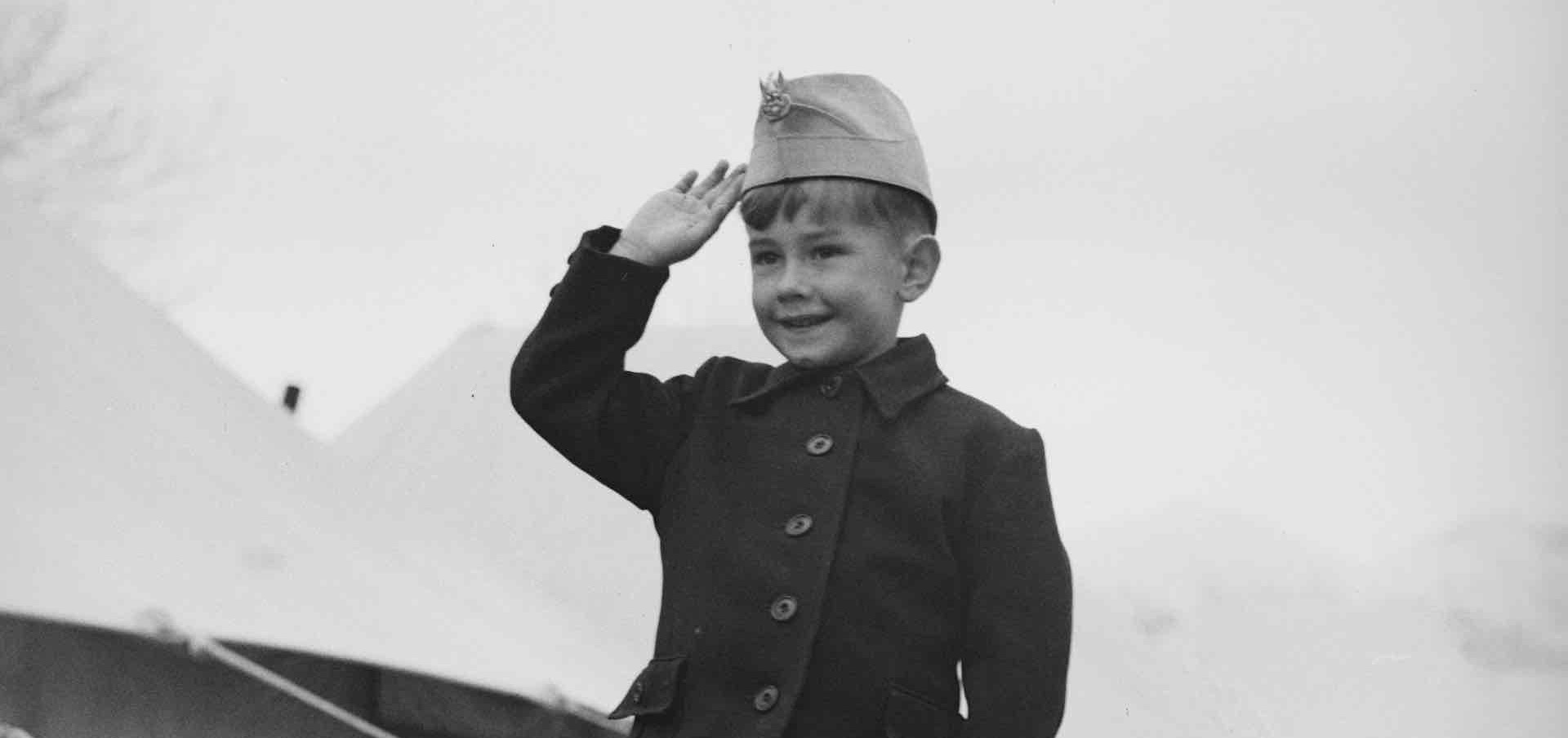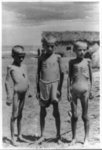U.S. Government Propaganda Photo (1943)
By Ted Lipien
The extent of the damage the initial propaganda from the Roosevelt administration had on the handling of the Polish World War II refugees story is not always easy to document, but some of the false information has kept reappearing in new forms for many years. After the arrival of the Internet, the Library of Congress posted online more than a dozen of the Office of War Information’s (OWI) propaganda photos of Polish refugees taken in 1943 in Iran without labeling them as part of a deceptive U.S. government propaganda effort to obscure the truth about the Soviet Union, which was carried out by OWI domestically and in its Voice of America (VOA) shortwave radio broadcasts abroad.1
While some of the photographs of children and women are indeed stunning, regrettably they convey an entirely false image of what they had been through in the Soviet Gulag. Those looking at the photos cannot tell from their inadequate online descriptions that the women had been imprisoned in the Soviet Union and had worked there as slave laborers before being evacuated to Iran. Some of the older children were also doing slave labor to keep themselves and their families from starving.
The Library of Congress online catalogue shows only one low-resolution photograph of three emanciated Polish girls of the World War II period. This photograph has an inadequate and confusing caption with no reference to Soviet Russia.2
The small image in the online Library of Congress collection, titled “This is how Polish children look when they arrive in Iran,” is attributed to the Polish American Council and its online record does not say from where these children came to Iran during the war. The mystery photo was probably taken in Iran in August 1942, most likely by a U.S. Army officer, Lt. Col. Henry I. Szymanski who reported to Washington in November 1942 that 50% of Polish children in Soviet captivity many have died from malnutrition and that “[Polish] Women not accustomed to hard manual labor and consequently not able to earn enough for their daily bread had a choice of starving to death or submitting to the Bolshevik or Mongol supervisor.”
His report was promptly classified as secret by Roosevelt administration officials and and was not made public until ten years later.3
Women of all nationalities were victim of repeated rapes by Soviet guards. Very few women refugees were willing to talk about it after the war. They were silenced by their trauma and shame. It was a precursor of what would be the fate of many women in East-Central Europe and millions of German women in the Soviet-occupied part of Germany.4 It was also not something that pro-Soviet leftist OWI propagandists would have found even remotely believable during the war and would want to publicize. They bought into Soviet propaganda lies that all Poles loyal to the Polish government in exile were reactionaries, anti-Semites and fascists.5 Supporting Stalin and propagandizing for the Soviet Union was, in their view, absolutely the right thing to do in the fight against fascism.
Lasting Effects of Propaganda

U.S. government officials in the Roosevelt administration had access to Szymanski’s photos of starved Polish children coming out of Russia and to other U.S. military and diplomatic reports on Soviet atrocities but classified them as secret to prevent their use by media outlets in the United States and abroad. Pro-Soviet OWI propagandists produced instead their own photographs, press releases and Voice of America radio broadcasts designed to mislead and confuse Americans and foreign audiences about the condition of wartime refugees who had been Stalin’s prisoners, without mentioning that they had been arrested, deported and cruelly mistreated by the Soviet communist regime.
The disinformation they produced not only had confused many independent journalists as it was being released; for many decades it has affected future media reporting by poorly-informed journalists. Propaganda can have a very long shelf life, as it has had in the case of Polish refugees.
It is, however, important to remember that not all Americans were deceived by Soviet and Roosevelt administration narratives about Stalin’s intentions. There were many, including members of Congress and some journalists outside of the OWI and VOA who were not afraid to point out fraud and deception in how Stalin and Soviet Russia were being sold to Americans by their own government in collusion with Russian propagandists.
While the active coordination of U.S. and Soviet propaganda lasted only a few years, some of its effects and impact continued much longer.6 There are thousands of public domain photographs online showing the victims from Nazi extermination and concentration camps and scenes of other German atrocities, but finding even a single photo of a former Polish adult male prisoner in the Soviet Gulag or a Polish mother and child as they really looked shortly after coming out of Russia during World War II is nearly impossible.
As of January 2019, the Library of Congress Prints and Photographs Division online catalogue has only one entry for “Gulag.” In an incredible affront to historical truth, the no longer intentional but still real legacy of silence about the Polish children refugees and other Gulag victims continues. The deception which the Roosevelt administration propaganda agency had initiated during the war in support of Soviet disinformation has been largely unreported and unchallenged. It is a worrisome testimony to the lasting effects of even decades-old attempts to manipulate public opinion, in this case in U.S. government’s collusion with a foreign power ruled by a totalitarian regime.
While later U.S. administrations had made significant efforts to counter Soviet propaganda, including the creation of Radio Free Europe and Radio Liberty in the early 1950s, misconceptions and avoidance of some sensitive topics by most other Western media have remained a long lasting problem.
The Soviet government engaged on its own in a massive disinformation campaign to suppress the truth about the Gulag and create confusion about what really happened to millions of innocent victims. On the Polish refugees and Katyń stories, as well as many others, the Soviets received active help from the Office of War Information and its Voice of America radio broadcasts. For several years, these U.S. government, taxpayer-funded institutions put out misleading information about 120,000 Polish refugees, soldiers and civilians—all of them Stalin’s former prisoners—who in 1942 had entered the British-controlled zone in Iran from Russia with his permission. By that time, Stalin wanted to get rid of the non-communist Polish Army, composed of former Gulag prisoners loyal to the Polish government in exile based in London. He was getting ready to break relations with the London Poles and to create his own puppet communist regime to rule Poland after the war.
Most mainstream U.S. media easily bought into the U.S. government propaganda campaign that the Polish refugees who came to Iran were saved by Stalin from Nazi oppression, with no word in OWI press releases and VOA radio broadcasts about those non-communist Poles who were executed or perished in Soviet Gulag camps.
Photo Credits
U.S. Government Propaganda Photo

- Title: Teheran, Iran. Young Polish refugee at an evacuation camp operated by the Red Cross
- Creator(s): Parrino, Nick, photographer
- Date Created/Published: 1943.
- Repository: Library of Congress Prints and Photographs Division Washington, D.C. 20540 USA
Photos by Lt. Col. Szymanski, U.S. Army, 1942

- Three sisters, ages 7, 8, and 9, Polish evacuees from Russia, August 1942
- Photos by: Lieutenant Colonel Henry I. Szymanski, U.S. Army
- Source: The Katyn Forest Massacre: Hearings Before The Select Committee to Conduct An Investigation on The Facts, Evidence and Circumstances of the Katyn Forest Massacre; Eighty-Second Congress, Second Session On Investigation of The Murder of Thousands of Polish Officers in The Katyn Forest Near Smolensk, Russia; Part 3 (Chicago, Ill.); March 13 and 14, 1952 (Washington: United States Government Printing Office, 1952), pp. 459-461.
- Link
Notes
- Farm Security Administration/Office of War Information Black-and-White Negatives, Library of Congress Prints and Photographs Division Washington, D.C. 20540 USA, http://www.loc.gov/pictures/related/?&pk=2017854318&st=gallery&sb=call_number#focus. OWI’s radio broadcasts were not generally known during World War II as “Voice of America.” They acquired that name later. OWI was also in charge of domestic propaganda which was later severely defunded by the U.S. Congress due to widespread public criticism. The Truman administration eliminated the OWI agency in 1942 and transferred the Voice of America to the State Department. The 1948 Smith-Mundt Act restricted domestic distribution of VOA programs. Some of these restrictions were lifted in legislation signed by President Obama.
- Library of Congress Prints and Photographs Division Washington, D.C. 20540 USA, “This is how Polish children look when they arrive in Iran.” Attributed to Polish American Council, ca. 1942, http://www.loc.gov/pictures/item/2003678080/.
- Eighty-Second Congress, Second Session On Investigation of The Murder of Thousands of Polish Officers in The Katyn Forest Near Smolensk, Russia; Part 3 (Chicago, Ill.), March 13 and 14, 1952, The Katyn Forest Massacre: Hearings Before The Select Committee to Conduct An Investigation on The Facts, Evidence and Circumstances of the Katyn Forest Massacre (Washington: United States Government Printing Office, 1952), 455, https://archive.org/details/katynforestmassa03unit/page/454.
- Marek Walicki who had escaped from Poland 1949 and later worked as a journalist for Radio Free Europe and the Voice of America, was a young boy when the Red Army moved into the area near Warsaw. He wrote in his memoir, Z Polski Ludowej do Wolnej Europy (“From Peoples’ Poland to Radio Free Europe”) published in 2018 in Poland: “The Soviets finally came. On the first day of ‘liberation’ they raped in our area several women. Some were raped until they died.” See: Marek Walicki, Z Polski Ludowej do Wolnej Europy (Warsaw: Bellona, 2018), 55.
- While there were anti-Semites among Poles as among any other nationalities, the Polish government in exile issued death sentences through its underground state in Nazi-occupied Poland against Poles who were denouncing Jews to the Germans. No Polish government was ever formed that would collaborate with the Germans in sending Jews to death camps, as was the case in some of the other European countries. The Polish government dispatched emissaries from Poland to warn Western leaders about the mass extermination of Jews. One of them was Jan Karski who met with President Roosevelt. His reports about the Holocaust were greeted then with some skepticism in Great Britain and in the United States. The Polish government in exile democratically represented all anti-Nazi and anti-Communist political parties in Poland, including Socialists. Jewish refugees were often denied U.S. visas and their requests for political asylum were often rejected because State Department officials insisted on strict interpretation of U.S. immigration laws while implementing the Roosevelt administration’s policy of limiting the flow of refugees to the United States.
- Ted Lipien, “75th Anniversary of Voice of America – Propaganda Coordination with USSR,” Cold War Radio Museum, April 14, 2018, http://www.coldwarradiomuseum.com/75th-anniversary-of-voice-of-america-propaganda-coordination-with-ussr/.


